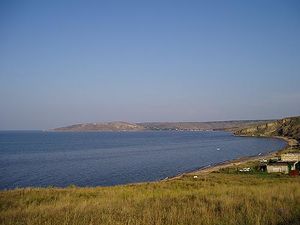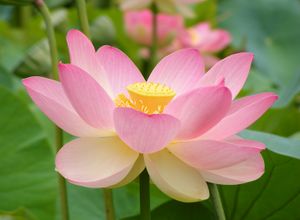بحر آزوف
| بحر آزوڤ | |
|---|---|
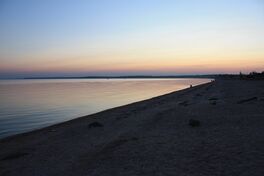 Sea of Azov shoreline at Nova Yalta, Donetsk Oblast | |
 Sea of Azov, upper right | |
| الإحداثيات | 46°N 37°E / 46°N 37°E |
| Type | Sea |
| الموارد الرئيسية | دون و كوبان |
| بلدان الحوض | Russia and Ukraine |
| أقصى طول | 340 كم |
| أقصى عرض | 135 كم |
| مساحة السطح | 37,555 كم²[1] |
| متوسط العمق | 13 متر[2] |
| أقصى عمق | 15.3 متر[2] |
| حجم المياه | 290 كم³[2] |
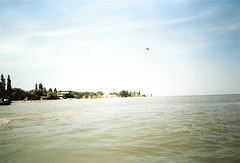
بحر آزوف (بالروسية:Азовское море، بالأوكرانية: Азовське море) بحر متفرع من البحر الأسود في جزئه الشمالي ويتصل به عن طريق مضيق كيرتش. يطل على الشواطئ الأوكرانية من شماله وعلى روسيا من جهة الغرب وشبه جزيرة القرم من الشرق.
التسمية والتاريخ
يذكر البعض أن التسمية جاءت من الحاكم الكوماني (أو القپچاق) (إحدى القبائل التركية) للمنطقة والذي مات دفاعا عن قرية قرب مياه البحر وكان يسمى بآزوف. يرجع آخرون التسمية لكلمة "آزاك" والتي تعني في التركية أرض منخفضة.
وفقا لنظرية طوفان البحر الأسود يعود تاريخ البحر لحوالي عام 5600 ق.م. وجدت بعض حملات تنقيب الآثار آثارا لمستوطنات تعود للعصر الحجري الحديث (النيوليتي) تحت مياه البحر. كان الإغريق يسمونه بالبحيرة الميوتية أو البحر الميوتي (باليونانية: ἡ Μαιῶτης λίμνη، باللاتينية: Palus Maeotis).
الجغرافيا
يبلغ طول بحر آزوف 340 كم وعرضه يضاهي الـ135 كم. تزيد مساحة البحر الإجمالية على 37 ألف كم2 (حوالي 14ألف ميل2). ملوحته منخفضة جدا في كثير من مناطقه إذ أنه بحر داخلي تصب فيه العديد من الأنهار كنهر دون وكوبان والعديد من الأنهار الأخرى القادمة من مناطق جليدية.
يعد بحر آزوف أقل بحار العالم انخفاضا إذ يصل متوسط عمقه لثلاثة عشر مترا فقط. اتجاه تياره دوراني عكس عقارب الساعة وأقصى ارتفاع لعمليتي المد والجزر لا يزيد عن 5 أمتار. من المدن المهمة المطلة عليه بيرديانسك وماريوبول وروستوڤ نا دونو وتاگاناروگ وييسك. يتصل ببحر قزوين عن طريق قناة مانيتش كما يتصل بقناة فولجا دون التي تربط نهري الفولجا بنهر الدون.
ويسمى طرفه الغربي سيفاش أو البحيرة المتعفنة، بسبب المستنقعات والأهوار الكثيرة كريهة الرائحة هناك. ويجعل الجليد والعواصف النقل بالسفن خطراً أثناء فصل الشتاء.
أهمية البحر الاقتصادية تنبع من الثروة السمكية فيه إذ يصل عدد أنواع السمك لحوالي 80 نوعا وأكثر من 300 نوع من اللافقاريات البحرية إلا إن هذه الأنواع آخذة بالتناقص بسبب عمليات الصيد الجائر والتلوث المنتشر فيه. أيضا يستغل البحر اقتصاديا باستخراج البترول من بعض مناطقه.
التاريخ
الهيدرولوجيا
- Sivash
- Bay of Arabat
- Taganrog Bay
- Temryuk Bay
- Kazantip Bay
- Berdyansk Bay
- Obytichna Bay
- Taman Bay
- Kerch Strait, connection with Black Sea
الأنهار
- Don
- Kuban
- Molochna
- Molochnyi Lyman
- Kalmius
- Malyi Utlyuk, Velykyi Utlyuk
- Utlyuk Estuary
- Atmanai
- Bolhradsky Sivashyk
- Mius
- Mius Estuary
- Yeya
- Yeisk Estuary
- Beysug
- Beysug Estuary
- Berda
- others
نظرية الطوفان
 مقالة مفصلة: نظرية طوفان البحر الأسود
مقالة مفصلة: نظرية طوفان البحر الأسود
حرب القرم 1854-1856
 مقالة مفصلة: حرب القرم
مقالة مفصلة: حرب القرم
النبيت والوحيش
Historically, the sea has had rich marine life, both in variety, with over 80 fish and 300 invertebrate species identified, and in numbers. Consequently, fishing has long been a major activity in the area. The annual catch of recent years was 300,000 tonnes, about half of which are valuable species (sturgeon, pike-perch, bream, sea-roach, etc.).[3] This was partly due to extremely high biological productivity of the sea, which was stimulated by the strong supply of nutrients from numerous rivers feeding the sea, low water salinity, ample heating due to shallow waters and long vegetation period. However, diversity and numbers have been reduced by artificial reduction of river flow (construction of dams), over-fishing and water-intense large-scale cultivation of cotton, causing increasing levels of pollution. Fish hauls have rapidly decreased and in particular anchovy fisheries have collapsed.[2][3][4][5]
Plankton and benthos

Because of the shallow waters, the development of aquatic life in the Sea of Azov is more characteristic of a lagoon, and the plankton patterns are rather similar in the open sea and near the shores. Despite its shallowness, the water has low transparency, so bottom plants are poorly developed and most algae are of planktonic type. The sea is characterised by high concentrations of organic matter and long blooming periods. Another specific feature of the sea is the variable salinity – low in the large bays and higher in the open sea, especially near the Kerch Strait. Therefore, the plankton species are distributed inhomogeneously in the Sea of Azov. Although many additional species are brought in from the saltier Black Sea, most of them cannot adjust to the variable salinity of the Sea of Azov, except for the euryhaline species.[6] About 600 species of planktonic algae are known in the Sea of Azov.[3] The number of species is dominated by diatoms and green algae; blue-green algae and pyrophites are significant, and euglena and yellow-green algae form only 5% of the species. Green algae are mostly responsible for the colour of the sea in the satellite images (see photos above).[6]
Regarding zooplankton, the fresh waters of the Tanganrog Bay are inhabited by cladocera, copepoda and rotifers, such as Brachionus plicatilis, Keratella curdata and Asplanchna. Western part of the sea, which is more saline, hosts three forms of Acartia clausi, as well as Centropages ponticus, meroplankton and larvae of gastropoda, bivalvia and polychaete.[7]
Benthos species reside mostly at the sea bottom and include worms, crustaceans, bottom protists, coelenterata and mollusks. Mollusks account for 60–98% of the invertebrate biomass at the Sea of Azov bottom.[7]
الأسماك
There are 183 ichthyofauna species from 112 genera and 55 families in the Sea of Azov region. Among them, there are 50 rare and 19 endangered species, and the sturgeon Acipenser nudiventris is probably extinct in the region.[8]
The fauna of the freshwater Taganrog Bay is much poorer – it consists of 55 species from 36 genera and 16 families; among them, three species are rare and 6 are endangered.[9]
النبيت
The shores of the Sea of Azov contain numerous estuaries and marshes and are dominated by reeds, sedges, Typha and Sparganium. Typical submerged plants are Charales, pond weed, hornworts and water lilies. Also common is sacred lotus.[10] The number of species is large; for example, the Belosaraysk and Berdyansk spits alone contain more than 200 each. Some spits are declared national nature reserves, such as Beglitsk,[11] Belosaraysk,[12] Krivaya[12] and Berdyansk Spits.[13][14][15]
الوحيش

Estuaries and spits of the sea are rich in birds, mostly waterfowl, such as wild geese, ducks and seagulls. Colonies of cormorants and pelicans are common. Also frequently observed are swans, herons, sandpipers and many birds of prey. Mammals include foxes, wild cats, hares, hedgehogs, weasels, martens and wild boar.[15] Muskrats were introduced to the area in the early 20th century and are hunted for their fur.[10]
Migrating and invading species
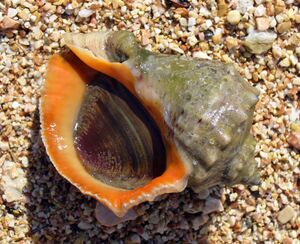
Some ichthyofauna species, such as anchovy, garfish, Black Sea whiting and pickerel, visit the Sea of Azov from the Black Sea for spawning. This was especially frequent in 1975–77 when the salinity of the southern Sea of Azov was unusually high, and additional species were seen such as bluefish, turbot, chuco, spurdog, Black Sea salmon, mackerel and even corkwing wrasse, rock hopper, bullhead and eelpout. Unlike the Black Sea plankton which does not adapt well to the low salinity of the Sea of Azov and concentrates near the Kerch Strait, fishes and invertebrates of the Black Sea adjust well. They are often stronger than the native species, are used to the relatively low temperatures of the Black Sea and survive winter in the Sea of Azov well.[16]
Balanus improvisus is the first benthos species which spread from the Black Sea in the early 20th century and settled in the Sea of Azov. Its current density is 7 kg/m2. From 1956, Rapana venosa is observed in the Sea of Azov, but it could not adjust to low salinity and therefore is limited to the neighborhood of the Kerch Strait. Several Sea of Azov mollusks, such as shipworm (Teredo navalis), soft-shell clam (Mya arernaria), Mediterranean mussel (Mytilus galloprovincialis) and Anadara inaequivalvis, originate from the Black Sea. Another example of invading species is the Dutch crab Rhithropanopeus harrisii which is observed both in saline and freshwater parts.[16]
Formerly three types of dolphins, short-beaked common dolphin, common bottlenose dolphin and harbour porpoise, regularly visited the Sea of Azov from the Black Sea although the common dolphin usually avoided the basin and Kerch Strait due to low salinity.[17] One type of harbour porpoise, Phocoena phocoena relicta, used to live in the Sea of Azov and was therefore called "Azov dolphin" (روسية: азовка) in the Soviet Union. Nowadays, dolphins are rarely observed in the Sea of Azov. This is attributed to shallowing of the sea, increasing navigation activities, pollution, and reduction in the fish population.[18][19]
Various species of pinnipeds and belugas[20] were introduced into Black Sea by mankind and later escaped either by accidental or purported causes. Of these, grey seal has been recorded within Kerch Strait and Sea of Azov.[21] Mediterranean monk seals became extinct in the Black Sea in 1997,[22] and historic presences of large whales such as minke whales into Black Sea is recorded,[23][24] although it is unclear whether these mammals historically occurred in the Azov Basin.
Economy and ecology
For centuries, the Sea of Azov has been an important waterway for the transport of goods and passengers. The first modern ironworks in Imperial Russia were located upstream on the Kalmius River at Donetsk, originally named Hughesovka (روسية: Юзовка). It was also important for the transportation of iron ores from the mines of the Kerch peninsula to the processing plant of Azovstal in Mariupol (formerly Zhdanov), Ukraine; this activity stopped after the closure of the mines in the 1990s.[25] Navigation increased after the construction in 1952 of the Volga–Don Canal which connected the Sea of Azov with the Volga River – the most important riverine transport route in the central Russia – thus connecting major cities such as Moscow, Volgograd and Astrakhan.[10] Currently, the major ports are in Taganrog, Mariupol, Yeysk and Berdyansk.[26][27]
Increasing navigation rates have resulted in more pollution and even in ecological disasters. On 11 November 2007, a strong storm resulted in the sinking of four ships in the Strait of Kerch, in the Russian Port of Kavkaz. The ships were the Russian bulk carriers Volnogorsk, Nakhichevan, Kovel and the Georgian Haji Izmail with a Turkish crew. Six other ships were driven from their anchors and stranded and two tankers were damaged (Volgoneft-139 and Volgoneft-123). As a result, about 1300 tons of fuel oil and about 6800 tons of sulfur entered the sea.[28][29]
Another traditional activity in the sea is fishing. The Sea of Azov used to be the most productive fishing area in the Soviet Union: typical annual fish catches of 300,000 tonnes converted to 80 kg per hectare of surface. (The corresponding numbers are 2 kg in the Black Sea and 0.5 كيلوغرام (1.1 lb) in the Mediterranean Sea.)[بحاجة لمصدر] The catch has decreased in the 21st century, with more emphasis now on fish farming, especially of sturgeon.
Traditionally much of the coastline has been a zone of health resorts.[30]
The irrigation system of the Taman Peninsula, supplied by the extended delta of the Kuban River, is favorable for agriculture and the region is famous for its vines. The area of the Sivash lagoons and Arabat Spit was traditionally a centre of a salt-producing industry. The Arabat Spit alone produced about 24,000 tonnes/year in the 19th century.[10][31]
الهامش
- ^ "Marine Litter Report".
- ^ أ ب ت ث Kostianoy, p. 65
- ^ أ ب ت ث Kostianoy, p. 76
- ^ Kostianoy, p. 86
- ^ Battle, Jessica Lindström (14 February 2004). Alien invaders in our seas. Archived from the original on 5 July 2014.
{{cite book}}:|website=ignored (help) - ^ أ ب Kostianoy, p. 77
- ^ أ ب Kostianoy, p. 78
- ^ Kostianoy, p. 79
- ^ Kostianoy, p. 81
- ^ أ ب ت ث خطأ استشهاد: وسم
<ref>غير صحيح؛ لا نص تم توفيره للمراجع المسماةkki - ^ Основные положения о территориальном планировании, содержащиеся в "Схеме территориального планирования рекреационного комплекса прибрежных территорий Азовского моря и Нижнего Дона" (in الروسية). Retrieved August 20, 2002.[dead link]
- ^ أ ب "List of nature reserves" (in الروسية). Archived from the original on December 22, 2007. Retrieved August 30, 2002.
- ^ خطأ استشهاد: وسم
<ref>غير صحيح؛ لا نص تم توفيره للمراجع المسماةb1 - ^ Basics of ecology (in الروسية). Ministry of Education and Science of Ukraine. 2005. Archived from the original on أبريل 26, 2010. Retrieved أغسطس 30, 2002.
- ^ أ ب "Berdyansk Spit" (in الروسية). Web Site of Berdyansk. Retrieved August 30, 2002.
- ^ أ ب Kostianoy, pp. 83–85
- ^ "The IUCN Red List of Threatened Species". IUCN Red List of Threatened Species. Retrieved 2018-10-25.
- ^ "Dolphins are leaving the polluted Sea of Azov" (in الروسية). Novosti.dn.ua. 19 February 2010.
- ^ Klinowska, M. (1991). Dolphins, porpoises and whales of the world: the IUCN red data book. IUCN. p. 89. ISBN 978-2-88032-936-5.
- ^ Anderson R.. 1992. Black Sea Whale Aided By Activists. Chicago Tribune. Retrieved on April 21. 2016
- ^ Grey seal Halichoerus grypus in the Black Sea: The first case of long-term survival of an exotic pinniped
- ^ Karamanlidis, A.; Dendrinos, P. (2015). "Monachus monachus". IUCN Red List of Threatened Species. 2015: e.T13653A45227543. doi:10.2305/IUCN.UK.2015-4.RLTS.T13653A45227543.en.
- ^ "Current knowledge of the cetacean fauna of the Greek Seas" (PDF). 2003: 219–232. Archived from the original (PDF) on 2008-09-07. Retrieved 2016-04-21.
{{cite journal}}: Cite journal requires|journal=(help) - ^ "Киты в Черном море (cached)". Archived from the original on 2019-02-03. Retrieved 2021-12-24.
- ^ Hirnycyj encyklopedycnyj slovnyk, Volume 3 (in الأوكرانية). Schidnyj Vydavnyčyj Dim. 2004. ISBN 978-966-7804-78-7.
- ^ خطأ استشهاد: وسم
<ref>غير صحيح؛ لا نص تم توفيره للمراجع المسماةbse1 - ^ خطأ استشهاد: وسم
<ref>غير صحيح؛ لا نص تم توفيره للمراجع المسماةbrit - ^ "EU experts to assess ecological situation in Kerch Strait". Web-Portal of the Ukrainian Government. March 18, 2008.
- ^ "Oil Spill Near Black Sea Causes 'Ecological Catastrophe'". Associated Press. November 13, 2007. Archived from the original on September 7, 2008. Retrieved August 30, 2002.
- ^ خطأ استشهاد: وسم
<ref>غير صحيح؛ لا نص تم توفيره للمراجع المسماةseas - ^ خطأ استشهاد: وسم
<ref>غير صحيح؛ لا نص تم توفيره للمراجع المسماةarabat
وصلات خارجية
- Azov sea beach-view webcam (located in Ukraine, Kirillovka, Gavayi recreation site)
- Pictures of Azov sea coast all along the Crimean peninsula - pics from private mountain guide Sergey Sorokin
- Pictures of Azov sea - Berdjanks - pics from private tour in CZ: Azovske more
- Theory that Atlantis sank beneath the Sea of Azov.
- Pages using gadget WikiMiniAtlas
- CS1 errors: periodical ignored
- CS1 uses الروسية-language script (ru)
- CS1 الروسية-language sources (ru)
- Articles with dead external links from May 2018
- CS1 الأوكرانية-language sources (uk)
- Short description is different from Wikidata
- Coordinates on Wikidata
- Articles containing روسية-language text
- Pages using Lang-xx templates
- Articles with unsourced statements from January 2013
- بحر آزوڤ
- جغرافيا القرم
- تضاريس اوكرانيا
- بحار روسيا
- بحار
- بحار البحر المتوسط


